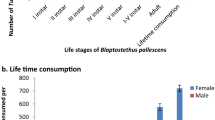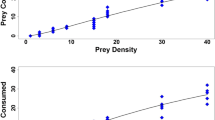Abstract
The litchi stink bug, Tessaratoma papillosa (Drury) (Hemiptera: Tessaratomidae), is a serious pest in the longan and litchi orchards in China. At present, the control of T. papillosa is heavily based on the use of insecticides, and the environmentally-friendly alternative strategies are urgently needed. The praying mantis, Hierodula patellifera (Serville, 1839) (Mantodea: Mantidae) and T. papillosa coexist in orchards. We assessed the potential of H. patellifera adults serving as a bio-control agent against T. papillosa by observing the predatory behavior of the mantis when the bugs were offered at different densities and different developmental stages under laboratory condition. The results showed that H. patellifera adults could be an effective biological control agent against T. papillosa as it exhibited Holling type II and type III functional response in the laboratory. Its consumption rates of prey increased with an increase in the density of prey offered but its search efficiency declined. The proportions of 1st -4th instar T. papillosa nymphs consumed by H. patellifera were higher than the other stages. Our results indicated that H. patellifera can be an effective biocontrol agent of T. papillosa, and these findings can guide the mass production efforts of this mantis.


Similar content being viewed by others
References
Ahn JJ, Kim KW, Lee JH (2010) Functional response of Neoseiulus californicus (Acari: Phytoseiidae) to Tetranychus urticae (Acari: Tetranychidae) on strawberry leaves. J Appl Entomol 134(2):98–104
Akaike H (1974) A new look at the statistical model identification. IEEE Trans Autom Control 19:716–723
Ali MP, Naif AA, Huang D (2011) Prey consumption and functional response of a phytoseiid predator, Neoseiulus womersleyi, feeding on spider mite, Tetranychus macferlanei. J Insect Sci 11:1–11
Borges M, Aldrich JR (1992) Instar-specific defensive secretions of stink bugs (Heteroptera: Pentatomidae). Cell Mol Life Sci 48:893–896
Gontijo LM, Nechols JR, Margolies DC, Cloyd RA (2012) Plant architecture and prey distribution influence foraging behavior of the predatory mite Phytoseiulus persimilis (Acari: Phytoseiidae). Exp Appl Acarol 56:23–32
Hatle JD, Salazar BA (2001) Aposematic coloration of gregarious insects can delay predation by an ambush predator. Environ Entomol 30:51–54
Holling CS (1959) ) Some characteristics of simple types of predation and parasitism. Can Entomol 91:385–398
Holling CS (1963) An experimental component analysis of population process. Mem Entomol Soc Can 32:22–32
Hyden K, Kral K (2005) The role of edges in the selection of a jump target in Mantis religiosa. Behav Process 70(2):122–131
Lester PJ, Harmsen R (2002) Functional and numerical responses do not always indicate the most effective predator for biological control: an analysis of two predators in a two-prey system. J Appl Ecol 39(3):455–468
Li DS, Liao C, Zhang BX, Song ZW (2014) Biological control of insect pests in litchi orchards in China. Biol Control 68:23–36
Marques FA, Wendler EP, Maia BHLNS, Ventura MU, Arruda-Gatti IC (2007) Identification of defensive compounds in metathoracic glands of adults of the stink bug Dichelops melacanthus (Hemiptera: Pentatomidae). J Braz Chem Soc 18(6):1242–1246
Montes-Molina JA, Luna-Guido ML, Espinoza-Paz N, Govaerts B, Gutierrez-Miceli FA, Dendooven L (2008) Are extracts of neem (Azadirachta indica A. Juss. (L.)) and Gliricidia sepium (Jacquin) an alternative to control pests on maize (Zea mays L.)? Crop Prot 27(3–5):763–774
Munyuli MBT, Luther GC, Kyamanywa S (2007) Effects of cowpea cropping systems and insecticides on arthropod predators in Uganda and Democratic Republic of the Congo. Crop Prot 26(2):114–126
Nguyen DT, Maxwell MR (2008) Stalking of stationary prey by a praying mantid (Hierodula patellifera Serville) (Mantodea: Mantidae). Entomol News 119(4):425–427
Noge K, Prudic KL, Becerra JX (2012) Defensive roles of (E)-2-alkenals and related compounds in Heteroptera. J Chem Ecol 38:1050–1056
Paradise CJ, Stamp NE (1991) Prey recognition time of praying mantids (Dictyoptera: Mantidae) and consequent survivorship of unpalatable prey (Hemiptera: Lygaeidae). J Insect Behav 4:265–273
Pervez A, Omkar (2005) Functional responses of coccinellid predators: an illustration of a logistic approach. J Insect Sci 5:5. https://doi.org/10.1093/jis/5.1.5
Poteser M, Kral K (1995) Visual distance discrimination between stationary targets in praying mantis: an index of the use of motion parallax. J Exp Biol 198:2127–2137
Prudic KL, Noge K, Becerra JX (2008) Adults and nymphs do not smell the same: the different defensive compounds of the giant mesquite bug (Thasus neocalifornicus: Coreidae). J Chem Ecol 34:734–741
Rocha L, Redaelli LR (2004) Functional response of Cosmoclopius nigroannulatus (Hem.: Reduviidae) to different densities of Spartocera dentiventris (Hem.: Coreidae) nymphae. Braz J Biol 64:309–316
Schulte MJ, Martin K, Sauerborn J (2006) Effects of azadirachtin injection in litchi trees (Litchi chinensis Sonn.) on the litchi stink bug (Tessaratoma papillosa Drury) in northern Thailand. J Pest Sci 79(4):241–250
Wang YJ, Zhao DX, Lu FP, Peng ZQ, Wang AP (2009) Electroantennogram and behavioral responses of Tessaratoma papillosa (Drury) (Hemiptera: Pentatomidae) to components of its metathoracic gland secretions. Acta Ecol Sin 29(11):5807–5812
Wang YJ, Zhao DX, Lu FP, Peng ZQ, Wang AP (2010) The population dynamics and spatial distribution pattern of Tessaratoma papillosa in lychee orchards. Chin Bull Entomol 47(5):958–961
Wang YJ, Wu J, Li RX, Zhao YN, Zhao DX (2014) Research on biological characteristics of Hierodula patellifera Serville in laboratory. China Plant Protect 34(3):5–8
Wang Y, Zhao D, Gao J, Peng Z (2015a) Determination of the volatile composition of Tessaratoma papillosa nymph by GC/MS. Chem Nat Compd 51:166–168
Wang YJ, Wu J, Zhao YN, Li RX, Zhao DX (2015b) Functional response and searching rate of giant Asian mantis Hierodula patellifera (Serville) nymphs to litchi stink bug Tessaratoma papillosa (Drury) nymphs. J Plant Protect 42(3):310–315
Yamawaki Y (1998) Responses to non-locomotive prey models by the praying mantis, Tenodera angustipennis Saussure. J Ethol 16:23–27
Yamawaki Y (2000) Effects of luminance, size, and angular velocity on the recognition of nonlocomotive prey models by the praying mantis. J Ethol 18:85–90
Zeng XN, Deng D, Wang JM (2001) Chlorpyrifos and cypermethrin for the control of litchi stink bug (Tessaratoma papillosa). Acta Hortic 558:421–423
Zhao D, Gao J, Wang Y, Jiang J, Li R (2012) Morphology and volatile compounds of metathoracic scent gland in Tessaratoma papillosa (Drury) (Hemiptera: Tessaratomidae). Neotrop Entomol 41:278–282
Acknowledgements
We thank Mr. GX Wang and Mrs. FN Chen (Hainan University, China) for rearing the mantises. This study was financially supported by National Nonprofit Institute Research Grant of CATAS-EPPRI (No. 2012hzs1J009).
Author information
Authors and Affiliations
Corresponding author
Ethics declarations
Conflict of interest
The authors declare that they have no conflict of interest.
Rights and permissions
About this article
Cite this article
Wang, S., Wu, J., Zhao, Y. et al. Functional response of adult Hierodula patellifera (Serville, 1839) (Mantodea: Mantidae) to Tessaratoma papillosa (Drury) (Hemiptera: Tessaratomidae). Int J Trop Insect Sci 40, 1053–1058 (2020). https://doi.org/10.1007/s42690-020-00166-z
Received:
Accepted:
Published:
Issue Date:
DOI: https://doi.org/10.1007/s42690-020-00166-z




